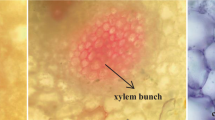Summary
It was the purpose of this study to investigate the effect of compound fertilization and compound fertilization with cupric sulfate on the growth and the bioelement content of cembra pine seedlings. At the same time microbiological investigations of the soil were carried out under the same conditions.
Five months after fertilization the seedlings of the plot treated with compound fertilizer showed lower total weights and lower bioelement contents in their organs than the seedlings in the untreated control plot and in the plot treated with copper.
In addition to these results it was found that in the plot treated with compound fertilizer there was an increase in the activity of those microorganisms which are probably nutrient competitors to the cembra pine seedlings whereas the plot treated with cupric sulfate showed a decrease in the activity of these microorganisms. The addition of cupric sulfate caused a partial elimination of this competition because of the toxic properties of the heavy metal and enabled the young cembra pine plants to increase their uptake of nitrogen, phosphorus and other bioelements.
In the control plot and in the plot treated with copper beginnings of mycorrhiza were observed. It could not be proved that the results were influenced by weed competition.
These observations have contributed to explaining the results of previous experiments which have always shown that fertilizers containing cupric sulfate favour the growth of cembra pine seedlings.
Similar content being viewed by others
References
Baumeister, W. und Ernst W. 1978 Mineralstoffe und Pflanzenwachstum. G. Fischer, Stuttgart, New York.
Bremner, J. M. 1965 Methods of Soil Analysis. Agronomy9, part 2. Ed. C. A. Black. A.S.A. Madison, Wisconsin, USA.
Domsch, K. H., Grabbe, K. und Fleckenstein, J. 1976 Schwermetallgehalte im Kultursubstrat und Erntegut des Champignons, Agaricus bisporus (Lange) Singer, beim Einsatz von Müllklärschlammkompost. Z. Pflanzenernaehr. Bodenkd.139, 487–501.
Duchaufour, Ph. 1965 Précis de Pédologie. 2e Ed. Masson et Cie, Paris.
Fiedler, H. J., Nebe, F. und Hoffmann, W. 1973 Forstliche Pflanzenernährung und Düngung. G. Fischer, Stuttgart.
Glatzel, G. 1976 Mineralstoffernährung und Aufkommen von Fichtenkulturen nahe der alpinen Waldgrenze. Cbl. ges. Forstw.93, 1–23.
Goor, van C. P. 1968 Spurenelemente bei der Ernährung von Koniferen. Dtsch. Akad. Landwirtsch. Wiss. Berlin, Tagungsber.84, 147–155.
Göbl, F. 1975 Erfahrungen bei der Anzucht von Mycorrhiza-Impfmaterial. Cbl. ges. Forstw.92, 227–237.
Göbl, F. 1979 Erfahrungen bei der Anwendung von Mycorrhiza-Impfmaterial (I. Zirbe). Cbl. ges. Forstw.96, 30–43.
Göbl, F. und Platzer, H. 1967 Düngung und Mycorrhizabildung bei Zirbenjungpflanzen. Mitt. Forstl. Bundes Versuchsanst. Wien, 74 p.
Göbl, F. und Pümpel, B. 1973 Einfluss von ‘Grünkupfer Linz’ auf Pflanzenausbildung, Mycorrhizabesatz sowie Frosthärte von Zirbenjungpflanzen. Eur. J. For. Pathol.3, 242–245.
Heilmann, P. E. and Gessel, P. 1963 The effect of nitrogen fertilization on the concentration and weight of nitrogen, phosphorus and potassium in Douglas-Fir trees. Soil Sci. Soc. Am. Proc.27, 102–105.
Hohenadl, R., Alcubilla, M. und Rehfuess, K. E. 1978 Die Stammbastanalyse als Methode zur Beurteilung des Ernährungszustandes von Coniferen. Z. Pflanzenernaehr. u. Bodenkd.141, 687–704.
Leyton, L. 1958 The mineral requirements of forest plants.In Handbuch der Pflanzenphysiologie IV, Ed. W. Ruhland. pp. 1026–1039.
Mengel, K. 1979 Ernährung und Stoffwechsel der Pflanze. G. Fischer, Stuttgart, New York.
Meisch, H. U., Schmitt, J. A. und Reinle, W. 1977 Schwermetalle in höheren Pilzen. Cadmium, Zink und Kupfer. Z. Naturforsch. C32, 172–181.
Moser, M. 1958 Die künstliche Mykorrhizaimpfung von Forstpflanzen. I, II. Forstw. Cbl.77, 32–40 und 273–278.
Moser, M. 1959 Die künstliche Mykorrhizaimpfung von Forstpflanzen III. Forstw. Cbl.78, 193–202.
Moser, M. 1964 Die Mykorrhizafrage bei der Anzucht von Forstpflanzen für das Hochgebirge. Forstsamengewinnung und Pflanzenanzucht für das Hochgebirge. BLV München 225–231.
Neuwinger, I. 1964 Wirkungen von Substrat und Düngung auf das Wachstum von Jungzirben. Forstw. Cbl.83, 129–192.
Neuwinger, I. und Gunsch, J. 1980 Über Jahresrhythmik im Nährstoffspiegel subalpiner Pflanzen und ihre Bedeutung beim Versetzen und Düngen von Jungzirben. Mitt. Forstl. Bundes Versuchsanst. Wien,Im Druck.
Petruzzelli, G. und Guidi, G. 1976 Influence of soil organic matter on copper availability to plants. Z. Pflanzenernaehr. Bodenkd.139, 679–684.
Pümpel, B., Göbl, F. und Tranquillini, W. 1975 Wachstum, Mycorrhiza und Frostresistenz von Fichtenjungpflanzen bei Düngung mit verschiedenen Stickstoffgaben. Eur. J. For. Pathol.5, 83–97.
Scheffer, F. und Schachtschabel, P. 1976 Lehrbuch der Bodenkunde, 9. Ed. F. Enke, Stuttgart.
Schinner, F. und Neuwinger, I. 1980 The influence of compound fertilizer and cupric sulfate on the soil microorganisms of Cembra Pine seedlings.In preparation.
Schinner, F., Niederbacher, R. und Neuwinger, I. 1980 The influence of compound fertilizer and cupric sulfate on soil enzymes and CO2-evolution. Plant and Soil57, 85–93.
Schinner, M., Neuwinger, I. und Schinner, F. 1980 The influence of compound fertilizer and cupric sulfate on the copper content of the root earth and the plant organs of Cembra Pine seedlings.In preparation.
Schlichting, E. 1965 Schwermetalle in typischen Böden der nordwestdeutschen Moränenlandschaft (insbesondere Kupfer in Podsolen). Z. Pflanzenernaehr. Dueng. Bodenkd.110, 93–109.
Schlichting, E. 1976 Cu, Co und Mo in Sesquioxid-Anreicherungshorizonten. Z. Pflanzenernaehr. Bodenkd.139, 223–228.
Schlichtung, E. und Blume, H. P. 1966 Bodenkundliches Praktikum. Parey, Berlin/Hamburg.
Shuman, L. M. 1979 Zinc, manganese and copper in soil fractions. Soil Sci.127, 10–17.
Smith, P. F. 1962 Mineral analysis of plant tissues. Annu. Rev. Plant Physiol.13, 81–108.
Author information
Authors and Affiliations
Rights and permissions
About this article
Cite this article
Neuwinger, I., Schinner, F. The influence of compound fertilizer and cupric sulfate on the growth and the bioelement content of cembra pine seedlings (Pinus cembra). Plant Soil 57, 257–270 (1980). https://doi.org/10.1007/BF02211686
Received:
Revised:
Issue Date:
DOI: https://doi.org/10.1007/BF02211686




